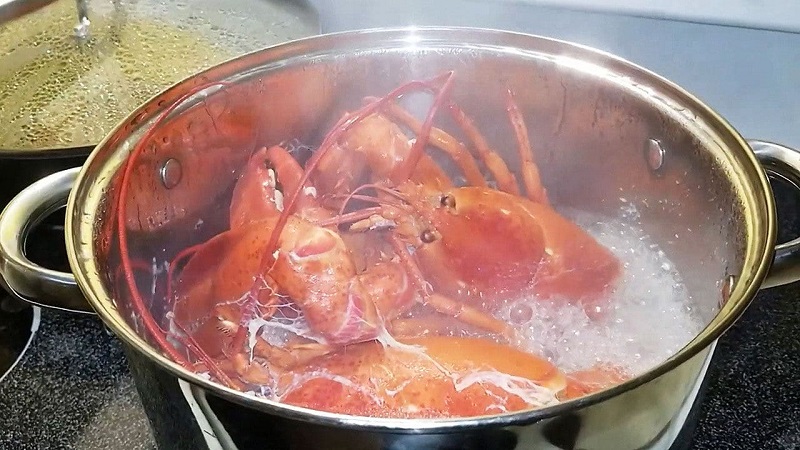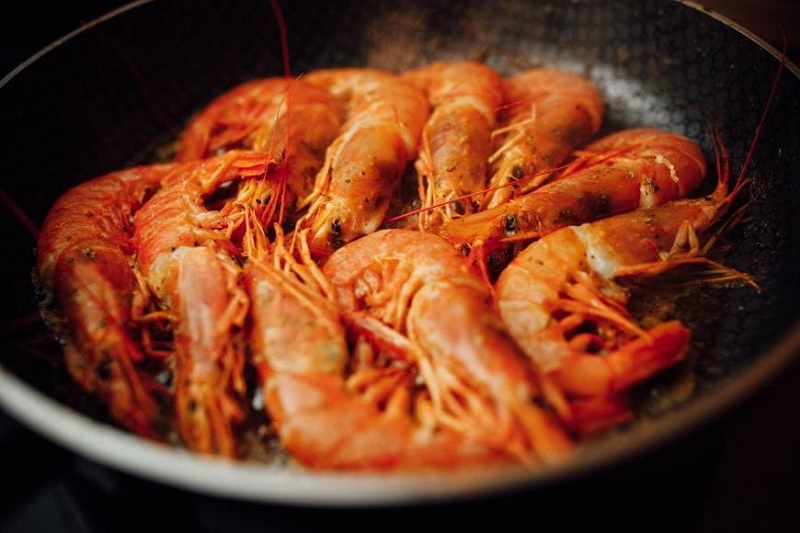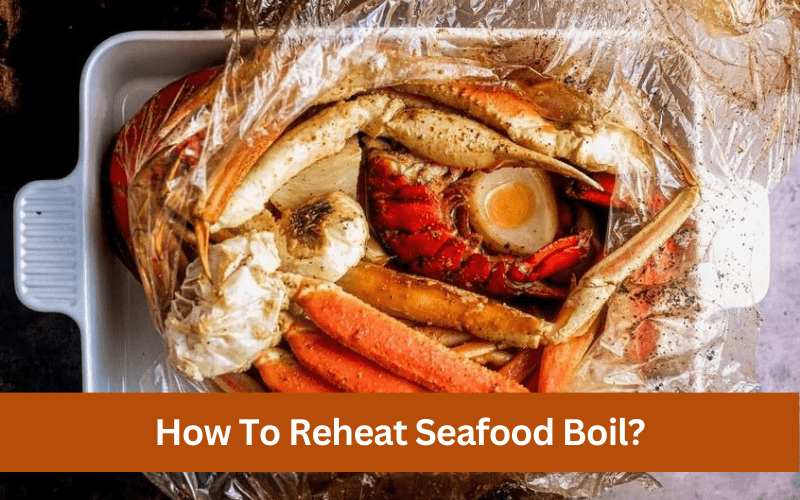As someone who loves to cook and experiment with different flavors, I’ve always been a big fan of seafood boils. There’s something special about gathering around a table with friends and family, cracking open crab legs and digging into a steaming pot of shrimp, potatoes, and corn.
However, one of the challenges of preparing a seafood boil is ensuring that there are no leftovers that go to waste. That’s where reheating comes in. Knowing how to reheat seafood boil correctly can make all the difference in the world, especially if you have a lot of food left over.
In this blog post, we’ll explore different methods for reheating seafood boil, including how to reheat seafood boil bag, and share some tips for enjoying your leftovers safely and deliciously. So if you’ve ever wondered how to reheat seafood boil, read on!
Why is seafood boil served in a plastic bag?
Seafood boils are often served in a bag for a few reasons:
- Convenience: Serving seafood boils in a bag is a convenient way to feed a large group of people. It allows for easy portioning and distribution of the seafood, and also makes cleanup easier since the bag can be disposed of after the meal.
- Flavor: When seafood boils are cooked in a bag, the seafood and seasonings are steamed together, which helps to infuse the seafood with the flavors of the spices and herbs. This results in a more flavorful dish that is evenly seasoned throughout.
- Moisture: Cooking seafood in a bag helps to retain its moisture, which can prevent it from becoming dry and overcooked. The bag also helps to prevent the seafood from absorbing too much water, which can lead to a soggy texture.
- Presentation: Serving seafood boils in a bag can also be visually appealing. The bright colors of the seafood and spices can be seen through the clear plastic, and the bag can be tied with a knot or bow for a decorative touch.
Overall, serving seafood boils in a bag is a popular way to prepare and serve this delicious dish, and it offers many benefits for both the cook and the diners.
What to know for reheating seafood boil with and without a bag?
Reheating seafood boil with a bag
- The best way to reheat seafood boil in a bag is to place it into a pot of boiling water.
- This method helps to retain the moisture and flavor of the seafood, and it’s also an effective way to reheat large quantities of seafood.
- To prevent the bag from bursting or leaking, it’s important to use a high-quality, heat-resistant bag that is designed for cooking.
- Stirring the seafood occasionally can help to distribute the heat evenly and ensure that it is reheated thoroughly.
Reheating seafood boil without a bag
- When reheating seafood boil without a bag, it’s important to use a method that will not dry out or overcook the seafood.
- The most effective methods include using a steam basket or boiling water with a strainer, which help to retain the moisture and flavor of the seafood.
- Other methods, such as using a pan or oven, may result in some parts of the seafood becoming overcooked or dry.
- To prevent the seafood from sticking to the pan or oven, it’s important to use a non-stick cooking spray or oil.
By following these key takeaways, you can ensure that your reheated seafood boil is safe, delicious, and retains its original moisture and flavor.
Methods of reheating seafood boil
How to reheat seafood boil on stove?
When it comes to reheating seafood boil on the stove, there are a few different methods you can try. As someone who has had to reheat seafood boil without a bag before, I can attest that it’s not as difficult as it may seem. Here are three methods I’ve used in the past:
- Pot of boiling water: This is the easiest and most straightforward method. Simply fill a pot with water and bring it to a boil. Once the water is boiling, carefully add your seafood boil ingredients to the pot and let them cook for a few minutes. Be sure to stir occasionally to ensure that everything heats up evenly. Once everything is heated through, use a slotted spoon or tongs to remove the seafood boil from the pot.

- Steam basket: If you have a steamer basket, this method can work well for reheating seafood boil without the bag. Fill a pot with about an inch of water and bring it to a boil. Place the seafood boil ingredients in the steamer basket and place the basket on top of the pot. Cover the pot with a lid and let the ingredients steam for a few minutes, or until they are heated through.
- Boiling water with a strainer: If you don’t have a steamer basket, you can also try reheating seafood boil by placing it in a strainer and submerging the strainer in a pot of boiling water. This method works especially well if you have a lot of ingredients to reheat. Simply fill a pot with enough water to cover the seafood boil and bring it to a boil. Place the strainer with the seafood boil inside the pot and let it cook for a few minutes, stirring occasionally to ensure even heating. Once everything is heated through, carefully remove the strainer from the pot and let it drain for a few minutes before serving.
Overall, reheating seafood boil on the stove without a bag can be a simple and easy process with the right tools and techniques. By using a pot of boiling water, a steamer basket, or a strainer and boiling water, you can enjoy your leftovers just as much as you did the first time around.
How long to reheat seafood boil in oven?
Reheating seafood boil in the oven is another great option for those looking to enjoy their leftovers. As someone who has reheated seafood boil in the oven many times, I can share some tips on how long to reheat it for, depending on the method you choose.
- Foil pack: To reheat seafood boil in a foil pack, start by preheating your oven to 350°F. Then, take a large piece of aluminum foil and place your seafood boil ingredients in the center. Fold the edges of the foil up to create a tight seal. Place the foil pack on a baking sheet and put it in the oven. Cook for 10-15 minutes, or until the seafood is heated through.

- Casserole dish: If you’re reheating a larger amount of seafood boil, using a casserole dish is a good option. Preheat your oven to 350°F, then transfer your seafood boil ingredients to a casserole dish. Cover the dish with aluminum foil and place it in the oven. Cook for 15-20 minutes, or until everything is heated through.
When reheating seafood boil in the oven, it’s important to keep an eye on it to make sure it doesn’t overcook or dry out. You may need to adjust the cooking time based on the size of your seafood boil and the strength of your oven. However, with these guidelines in mind, you should be able to enjoy delicious, reheated seafood boil from the oven in no time.
How to reheat seafood boil bag in microwave?
Reheating seafood boil in the microwave can be a quick and easy way to enjoy your leftovers. Here are three methods I’ve used to reheat seafood boil bag in the microwave based on personal experience:
- Microwave-safe dish: Start by transferring your seafood boil bag to a microwave-safe dish. Make sure the dish is large enough to hold all the ingredients without spilling over. This will help ensure that the seafood boil heats evenly in the microwave.
- Water or broth: To prevent the seafood from drying out, add a small amount of water or broth to the dish. This will help create steam and keep the seafood moist during the reheating process. I typically add about 1/4 cup of liquid per serving of seafood boil.
- Stirring method: To ensure that everything heats evenly, use the stirring method when reheating seafood boil in the microwave. Start by heating the seafood for 1-2 minutes on high power, then use a spoon or fork to stir the ingredients. Continue microwaving in 1-minute intervals, stirring after each interval, until the seafood is heated through.
Keep in mind that microwave times can vary based on the strength of your microwave and the amount of seafood you’re reheating. Be sure to keep a close eye on the seafood to make sure it doesn’t overcook or dry out. With these tips in mind, you should be able to reheat your seafood boil bag in the microwave quickly and easily.
Read more: How To Reheat Shrimp: A Comprehensive Guide To Keeping Your Leftovers Delicious
How to reheat seafood boil in pan?
Reheating seafood boil in a pan is a great option if you want to add some extra flavor to your leftovers. Here are some tips based on my personal experience:
- Heat a skillet: Start by heating a large skillet over medium heat. You want the skillet to be hot enough to quickly reheat the seafood, but not so hot that it burns.
- Add some liquid: To prevent the seafood from drying out, add a small amount of liquid to the skillet. You can use water, broth, or even leftover seafood boil liquid. I typically add about 1/4 cup of liquid per serving of seafood boil.
- Add the seafood: Once the liquid is heated, add the seafood to the skillet. Be sure to spread the seafood out in an even layer so that everything heats evenly. You can add any additional seasonings or spices at this point as well.
- Stir occasionally: To ensure that everything heats evenly, stir the seafood occasionally as it cooks. You can use a spatula or tongs to flip the larger pieces of seafood, such as crab legs or lobster tails.
- Cook until heated through: Depending on the amount of seafood you’re reheating, it should take about 5-10 minutes for everything to heat through. Keep a close eye on the seafood to make sure it doesn’t overcook or dry out.
Once the seafood is heated through, you can transfer it to a serving dish and enjoy! Reheating seafood boil in a pan is a great way to add some extra flavor and crispness to your leftovers.

How to reheat seafood boil in air fryer?
Reheating seafood boil in an air fryer is a great option if you want to add some crispness to your leftovers. Here are some tips based on my personal experience:
- Preheat the air fryer: Start by preheating your air fryer to 350°F. This will ensure that the seafood cooks evenly and quickly.
- Add the seafood: Once the air fryer is heated, add the seafood to the basket. Be sure to spread the seafood out in an even layer so that everything heats evenly. You can add any additional seasonings or spices at this point as well.
- Spray with oil: To help create a crispy texture, spray the seafood with a light layer of oil. You can use cooking spray or a pastry brush to apply the oil.
- Cook for 5-10 minutes: Depending on the amount of seafood you’re reheating, it should take about 5-10 minutes for everything to heat through and become crispy. Keep a close eye on the seafood to make sure it doesn’t overcook or burn.
- Shake the basket: To ensure that everything cooks evenly, shake the air fryer basket once or twice during the cooking process. This will help ensure that the seafood is evenly exposed to the hot air.
Once the seafood is heated through and crispy, you can transfer it to a serving dish and enjoy! Reheating seafood boil in an air fryer is a great way to add some extra texture and flavor to your leftovers.
So, what is the best way to reheat a seafood boil?
Here’s a comparison table of the different methods of reheating seafood boil we discussed earlier:
| Method | Pros | Cons |
| Stove | Simple and effective. Allows you to add extra flavor to your leftovers. | Can be time-consuming. May not provide the same level of crispiness as other methods. |
| Oven | Great for reheating a large quantity of seafood at once. A hands-off method that allows you to multi-task. | Takes longer than other methods. May dry out the seafood if not covered properly. |
| Microwave | Quick and easy. Doesn’t require any special equipment. | May not provide the best texture or flavor. Can make the seafood rubbery or chewy. |
| Air fryer | Adds extra crispiness and flavor to the seafood. A hands-off method that allows you to multi-task. | Requires special equipment. May not be suitable for reheating large quantities of seafood. May overcook the seafood if not monitored closely. |
Ultimately, the best method for reheating seafood boil depends on personal preference, the amount of seafood you need to reheat, and the tools you have available. Experiment with different methods to find the one that works best for you!
Tips for reheating seafood boil
How long does it take to reheat seafood boil?
The length of time it takes to reheat seafood boil will depend on the method you use and the amount of seafood you’re reheating. Here’s a general estimate of how long each method may take:
- Stove: Reheating seafood boil on the stove can take anywhere from 5 to 15 minutes, depending on the amount of seafood and the method you use.
- Oven: Reheating seafood boil in the oven can take anywhere from 15 to 30 minutes, depending on the amount of seafood and the temperature you use.
- Microwave: Reheating seafood boil in the microwave can take anywhere from 2 to 5 minutes, depending on the amount of seafood and the power of your microwave.
- Air fryer: Reheating seafood boil in an air fryer can take anywhere from 5 to 10 minutes, depending on the amount of seafood and the temperature you use.
- Pan: Reheating seafood boil in a pan is also a popular method, and it can take anywhere from 5 to 10 minutes, depending on the amount of seafood and the temperature you use.
These are just estimates, and the actual time it takes to reheat seafood boil may vary depending on the specific method you use and the amount of seafood you’re reheating. It’s important to monitor the seafood closely to ensure it’s heated through and not overcooked.
How to store leftover reheated seafood boil?
To store leftover reheated seafood boil, follow these steps:
- Let the seafood cool down to room temperature before storing it in the refrigerator or freezer.
- If you’re storing it in the refrigerator, transfer the seafood to an airtight container or resealable plastic bag. Make sure the container is tightly sealed to prevent any air from entering.
- Label the container or bag with the date and contents so you can easily identify it later.
- If you’re storing it in the freezer, place the container or bag in the freezer and make sure it’s tightly sealed.
- When you’re ready to eat the leftovers, reheat them using one of the methods we discussed earlier.
How many times can you reheat seafood boil?
You should only reheat seafood boil one time. Reheating it multiple times can increase the risk of bacterial growth and foodborne illness. If you have leftovers that you don’t think you’ll be able to finish within a few days, it’s better to store them in the freezer instead of the refrigerator. This will help to preserve their quality and safety for a longer period of time.
What temp to reheat seafood boil?
To prevent the growth of harmful bacteria, it’s important to reheat seafood boil to an internal temperature of 165°F (74°C). This temperature is high enough to kill any bacteria that may have grown while the seafood was being stored.
Using a food thermometer is the most accurate way to check the temperature of the seafood. When reheating seafood boil, make sure to stir it frequently and evenly distribute the heat to ensure that all parts of the seafood reach the correct temperature. Additionally, it’s important to only reheat leftovers one time to further reduce the risk of bacterial growth and foodborne illness.
Explore more: 5 Foolproof Methods On How To Reheat Crawfish
Tips for serving reheated seafood boil
Here are some tips for serving reheated seafood boil based on personal experience:
Garnishes
Adding garnishes to your reheated seafood boil can help to elevate its flavor and presentation. Some popular garnishes include chopped fresh herbs, sliced lemon, and hot sauce. You can also add some additional seafood or vegetables to your reheated seafood boil to add more texture and flavor.
Pairings
Pairing your reheated seafood boil with the right side dishes and beverages can help to create a well-rounded meal. Some popular pairings include crusty bread, rice, or cornbread, and cold beer or a crisp white wine. You can also serve a fresh salad or vegetable side dish to balance out the richness of the seafood boil.
Presentation
Presentation is key when serving reheated seafood boil. You can make your dish look more appealing by arranging the seafood in a visually appealing way or by using colorful serving dishes. Consider using a large platter or bowl to serve the seafood boil family-style, or use individual bowls or plates for a more formal presentation.
What can I do with leftover seafood boil liquid?
Leftover seafood boil liquid can be used in a variety of ways. Here are some ideas:
- Make a seafood stock: The leftover liquid can be used as a base for a flavorful seafood stock. Simply strain out any solids, and use the liquid in place of water or chicken broth in recipes like soups, stews, and chowders.
- Flavor rice or pasta: You can use the leftover liquid to cook rice or pasta to give it a flavorful boost. Just substitute some of the water with the seafood boil liquid when cooking.
- Make a sauce: The leftover liquid can be used as a base for a tasty seafood sauce. Simmer the liquid with some butter, garlic, and herbs to create a flavorful sauce that can be drizzled over grilled seafood or pasta dishes.
- Freeze for later use: If you don’t have an immediate use for the leftover liquid, you can freeze it for later use. Simply pour the liquid into an airtight container or freezer bag and freeze until ready to use.
Conclusion
Knowing how to reheat seafood boil is essential if you want to enjoy this delicious dish again without compromising its quality and safety. Whether you choose to reheat seafood boil with or without a bag, there are various methods that you can use, such as boiling water, a steam basket, an oven, or a microwave.
Each method has its advantages and disadvantages, so it’s important to choose the one that suits your needs and preferences. Remember to store leftover seafood boil correctly and reheat it only once to avoid the risk of food poisoning.





